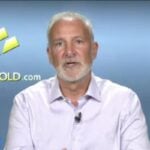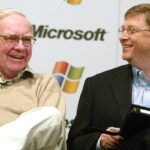We adhere to strict standards of editorial integrity to help you make decisions with confidence. Some or all links contained within this article are paid links.
The price of gold has surged 24% in 2024 and is currently around $2,570 an ounce. It has lowered since reaching an all-time-high in October, but according to Peter Schiff, chief economist and global strategist at Euro Pacific Asset Management, this rally might just be the beginning.
During an interview with “The Lead-Lag Report” last month, Schiff offered an ambitious forecast for the precious metal.
“If gold can go from $20 an ounce to $2,600 an ounce, it can go from $2,600 to $26,000, or to $100,000,” he stated.
At today’s prices, a climb to $100,000 would represent an impressive upside of over 3,700%.
And there could be even more room for growth, as Schiff emphasized, “There’s no limit because, cause again, gold’s not changing — all we’re doing is decreasing the value of the dollar.”
Schiff is the founder and chairman of precious metals dealer SchiffGold and serves as an investor and advisor at Goldmoney, a company that offers precious metals trading services, including storage solutions.
US dollar poised to ‘lose so much value’
Schiff’s bold forecast for gold’s future price is rooted in his long-held view on the risks of excessive money printing and inflation.
“I think the potential [for gold] is much higher because we’re just going to print so much money. We’re going to have so much inflation that the dollar is going to lose so much value that you’re really going to need a lot of dollars to buy gold,” he explained.
Gold has long been considered a popular hedge against inflation. Unlike fiat currency, the yellow metal can’t be printed in unlimited quantities by central banks. And with its value untethered to any specific currency or economy, gold often acts as a "safe haven" asset, especially during periods of economic or geopolitical uncertainty.
One way to invest in gold that also provides significant tax advantages is to open a gold IRA with the help of American Hartford Gold. Gold IRAs allow investors to hold physical gold or gold-related assets within a retirement account, thereby combining the tax advantages of an IRA with the protective benefits of investing in gold, making it an attractive option for those seeking to ensure their retirement funds are well shielded against economic uncertainties.
When you sign up with American Hartford Gold, you’ll be eligible for an offer to receive up to $15,000 in free silver, along with the assurance of the best pricing through their price match guarantee.
9% inflation in 2025?
The headline inflation rate in the U.S. has subsided. In October 2024, the U.S. consumer price index showed a 12-month increase of 2.6%, a significant drop from its recent peak of 9.1% in June 2022.
While some economists have declared victory in the fight against inflation, Schiff has a different view.
“[Inflation] is not gone at all — it’s going to reemerge stronger than ever, not that it ever disappeared,” he stated.
“The CPI is finished going down and now it’s headed back up … we’ve been banging around 3% for the last year or so — that’s kind of like the bottom. And I think we’re trending back up and by 2025, we can easily be back up at 9% again year over year, maybe higher.”
Schiff isn’t just voicing predictions; he’s investing according to his beliefs. The latest 13F filing from Euro Pacific Asset Management reveals a significant emphasis on gold within Schiff’s investment strategy.
As of Sept. 30, the largest holding at Euro Pacific Asset Management was gold mining company Agnico Eagle Mines (AEM). Meanwhile, Euro Pacific’s second-largest holding was Barrick Gold (ABX), another heavyweight player in the gold mining business.
Whether or not you share Schiff’s enthusiasm for gold mining stocks, it’s easier than ever to start investing. Trading apps like Public allow everyday investors to capitalize on the stock market by investing in fractional shares for as little as $5. You can easily pack your portfolio with your favorite companies, with zero commissions.
Of course, not all stocks are the same. To make more informed decisions, investors can use research tools like Moby, which provide expert analysis and market insights, helping users optimize their portfolios.
This article provides information only and should not be construed as advice. It is provided without warranty of any kind.



